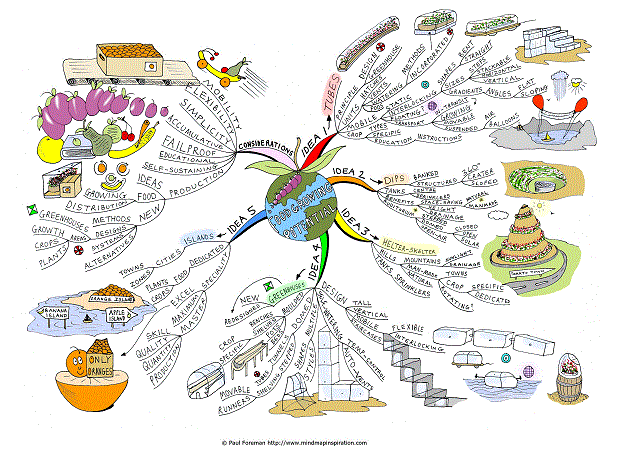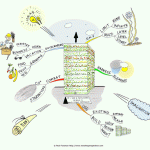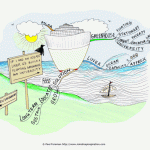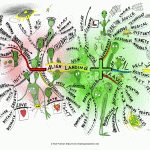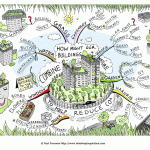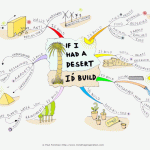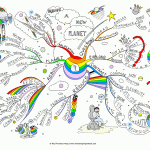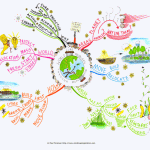I created the following Mind Maps to explore new possibilities for growing food and how we might work with the planet to combat starvation in the world:
How might our buildings combine with nature? Mind Map
Cure world problems through relocation Mind Map
If I had a desert Mind Map
If I built greenhouses Mind Map
If I had an ocean liner Mind Map
If I had a skyscraper Mind Map
Mixing problems to create solutions Mind Map
The design of greenhouses and methods of growing food have largely stayed the same over the years – so perhaps there might be new ways of growing. New designs and modern alternatives; ways to expand our food growing potential.
In addition to existing greenhouse designs and growing methods, in what other ways might we be able to grow our food?
The above Food Growing Potential Mind Map explores some initial thinking – ideas that I hope others can contemplate, build on and better. I think by using our imagination we can invent new ways to produce foods and make use of the often perfect growing environment that the planet offers us.
Here are my thoughts and ideas for new food growing potential:
Idea One – Food growing tubes
Might we be able to produce tubes that work on the greenhouse principle, yet with a method of watering plants from beneath the soil and utilising condensation?
The tubes could be tailor-made and variety specific; the tops being a few feet above plant heights and have vents and hatches for access. They could come in varying lengths, almost like miniature train carriages. They might even be designed as mobile units, or even floating units. If a slight gradient were introduced watering might be simpler and more effective. These tubes could become “pods” to kick-start growing and be despatched wherever required – “transported in-transit growing”. The tubes could be horizontal, or step-stackable or even vertical; the design could be straight, bent, angled, sloping, interlocking, perhaps even suspended in the air and held up by balloons?
If crop specific they could have growing and caring instructions on the outside – detailed and yet simple advice for cultivating the plants, so that the tubes become not only alternative methods of growing food, they also have an added educational element.
Idea Two – Banked dips or auditoriums; both natural and manmade
I have seen trees and bushes growing in huge bomb craters – a fascinating show of the planets potential for recovery and growth. Taking the example further, dips; banked areas, with central reservoir tanks could be an answer to growing. Manmade dips could be created by digging down or building up and hollowing out, or designing entire new purpose built auditorium like structures. The benefits are making good use of space and taking advantage of natural drainage. Sprinkler systems might even be used to distribute collected excess rainwater. Manmade units similar to open-air auditoriums could be created with 360° stepped growing and drainage beneath the stepped areas down to central reservoir tanks with sprinklers. Some auditoriums or dips could possibly even have domed covers to control rainfall and even collect solar energy.
Idea Three – Helter-skelter
We could grow food top to bottom, down hills or manmade structures, perhaps in a helter-skelter design with systems for catching, making good use of and collecting rainfall. Manmade structures could be as high as you like, convert existing hills, or make new mini-towns, with access roads up the hills – perhaps dedicated to crops. At the foot of converted hills or manmade structures, collection tanks could utilise excess water. Manmade versions might even be rotatable to follow the sun?
Idea Four – Redesigning greenhouses
What could our greenhouses look like in the future? Might they be moulded with built-in benches, shelves, pots or beds? Some could be dome tunnels with stepped, movable shelving on runners. Multiple shapes and styles; greenhouses specific and ideal for certain types of plants. Self-watering? Temperature-controlled? Automatic vents? Tall greenhouses; vertical greenhouses, greenhouses designed to follow staircases? Over and above standard designs anything is possible!
Idea Five – Islands dedicated to plants and crops or specific foods
Imagine islands around the globe dedicated to a variety of plants, foods or crops. Specialising in type and variety; mastering and maximising the production, quantity and quality. Imagine Banana Island, Apple Island, and Orange Island.
Imagine a City of Growth – an entire city dedicated to food!
The above ideas represent only a small amount of potential new ways to grow food; there will be many more and better possibilities. I think mobility is a key issue – if we can come up with ideas that create mobile and movable sources of food growth; that is, plants growing in transit, we can transport and distribute food around the world to where it is needed, whenever we need to.
What other ways might we, as individuals and as a planet, grow food and how might we get food to those who need it? More importantly, what systems might we design to combine growing and education so that those who need food can become self-sustaining? How can we design fail proof systems? How might we go about growing food anywhere in the world by working with the planet and creating the right combination for food growth?
Answers to questions like these will help feed the world, dramatically reduce starvation and possibly one day eradicate it.
More from Mind Map Inspiration:
Submit your review | |

